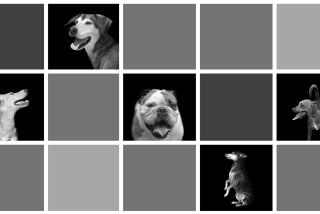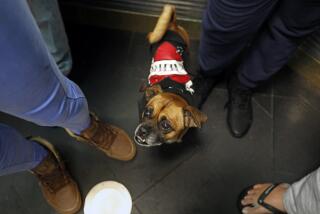Our Pets, Ourselves : THE BEAST IN THE BOUDOIR: Petkeeping in Nineteenth-Century Paris, <i> By Kathleen Kete (University of California Press: $30; 204 pp.)</i>
- Share via
Seduced by the title, you might pick up Kathleen Kete’s “The Beast in the Boudoir” and plunge right in, anticipating imperiled heroines and their virile swains--a potential bodice-ripper extraordinaire. Go a few sentences deep, and you’ll know you’ve been mistaken. For the detail-laden text earnestly sets about explicating (as the subtitle warned, even if you didn’t stop to notice) pet-keeping practices in 19th-Century Paris and the ways in which domesticated dogs and cats allowed the members of the bourgeoisie to imagine themselves. Though not the lurid read you’d craved, the book harbors its own temptations, and it pays to stick with Kete as she probes the complex relationship between man, woman and beast.
One of Kete’s clearest arguments centers on the bourgeois response to modernity to a world turned “alienating, and relentlessly unsentimental,” over the course of the 19th Century. “The pet,” Kete explains, “became the countericon of the scientific, and dehumanized, age.” Dissatisfied with the faithlessness of people, daunted by the emptiness of their lives, bourgeois pet-keepers turned to their dogs, models of fidelity and affection. Sifting through such sources as the annals of the Parisian Animal Protection Society, as well as newspaper accounts, Kete bolsters her point with contemporary tales of superlative canines: dogs who performed daring rescues, dogs who journeyed rough miles to return home, dogs who grieved after the death of their masters, sometimes committing suicide.
Indeed, one of the joys of “The Beast in the Boudoir” is Kete’s able use of 19th-Century texts. In addition to the publications of the Animal Protection Society, Kete culls from records on the dog tax, veterinary literature, dog-care books and writings on pet cemeteries. Nineteenth-Century voices, musing, enthusing and arguing over the merits of myriad beloved beasts, enliven the author’s scholarly tone, which remains, at all times, properly dispassionate.
Contemporary references to cats were particularly charged, perhaps, as Kete suggests, because of the danger that feline symbolism--fickleness, bohemian independence--posed to the goals of order and security that structured class-conscious bourgeois life. The sentiments of the 18th-Century naturalist Buffon informed 19th-Century discourse on cats. Kete quotes Buffon’s opinion that cats “have an innate malice, a falseness of character, a perverse nature.’ ” Worse still, cats, especially female ones, exuded rampant sexuality.
So perhaps we have hit upon some disguised bodice ripping after all. To be sure, Kete’s discussion of rabies--a disease characterized, in the 19th-Century mind, by violence and insatiable sexual impulses--is one of the highlights of the book. “It was the beastly appetites of humanity,” the author declares, “that were expressed in the symptomatology of rabies and it seems striking that in an age typified by repression of appetites, la bete humaine attracted fascinated, if horrified, attention.” Always striving to maintain the primary ideals of self-discipline and control, the bourgeoisie imposed culture in place of nature--and not just human nature. “The paradox of a culture bent on banishing nature from the home,” Kete notes, “resolved itself into the construction of a shadow world of denatured animals.” Dogs were treated as dolls or children; they were subjected to the latest fads in coiffure and couture. Their training, in terms of sexuality and obedience, “marked the transformation of beastly behavior into quasi-human conduct.”
Many of us still anthropomorphize our domesticated companions, requiring them to live on our terms. Indeed we continue to elaborate, on many counts, the pet-keeping models of the 19th-Century. Dog remains man’s best friend in a world that has propelled us toward ever-more-isolating realms of modernity. And just like the infantilized pets of the last century, dogs and cats are our surrogate children, necessary constructs ranged against today’s specter of the decaying family.
Yet the 20th-Century is beset with its own anxieties, foremost among them our destruction of the environment. Although I don’t pretend to be the thorough cultural historian Kete has proved herself, I would venture to guess this distinguishes us unmistakably from the animal fanciers of the previous century. Fearful of precipitating the extinction of the natural world, now we court the beast. In her recent bestseller, “The Hidden Life of Dogs,” Elizabeth Marshall Thomas writes, “I would like to visit a dog’s mind, to know what he’s thinking and feeling, to have another dog look at men and see not something different but something the same.” In our dogs we see the wolf, in our cats the lion. And, more often than not, our deepest urge is to follow them out to the scented mountains, to the wild plains and roam beneath a waxing moon.
More to Read
Sign up for our Book Club newsletter
Get the latest news, events and more from the Los Angeles Times Book Club, and help us get L.A. reading and talking.
You may occasionally receive promotional content from the Los Angeles Times.








